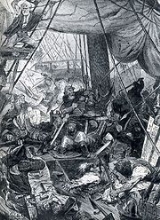
Simon of Utrecht
Encyclopedia

Hanseatic League
The Hanseatic League was an economic alliance of trading cities and their merchant guilds that dominated trade along the coast of Northern Europe...
during the Middle Ages
Middle Ages
The Middle Ages is a periodization of European history from the 5th century to the 15th century. The Middle Ages follows the fall of the Western Roman Empire in 476 and precedes the Early Modern Era. It is the middle period of a three-period division of Western history: Classic, Medieval and Modern...
. He was probably born in Flanders
Flanders
Flanders is the community of the Flemings but also one of the institutions in Belgium, and a geographical region located in parts of present-day Belgium, France and the Netherlands. "Flanders" can also refer to the northern part of Belgium that contains Brussels, Bruges, Ghent and Antwerp...
, but emigrated to Hamburg
Hamburg
-History:The first historic name for the city was, according to Claudius Ptolemy's reports, Treva.But the city takes its modern name, Hamburg, from the first permanent building on the site, a castle whose construction was ordered by the Emperor Charlemagne in AD 808...
, Germany
Germany
Germany , officially the Federal Republic of Germany , is a federal parliamentary republic in Europe. The country consists of 16 states while the capital and largest city is Berlin. Germany covers an area of 357,021 km2 and has a largely temperate seasonal climate...
, where he received citizenship in 1400. He became famous for capturing the pirate Klaus Störtebeker
Klaus Störtebeker
Nikolaus Storzenbecher, or Klaus Störtebeker , was a leader and the best known representative of a companionship of privateers known as the Victual Brothers...
in 1401.
Based on his popularity stemming from his battle against the Likedeelers
Victual Brothers
The Victual Brothers were a companionship of privateers who later turned to piracy. They were hired in 1392 by the Dukes of Mecklenburg to fight against Denmark, because the Danish Queen Margaret I had imprisoned Albrecht of Mecklenburg and his son in order to subdue the kingdom of Sweden...
at Heligoland
Heligoland
Heligoland is a small German archipelago in the North Sea.Formerly Danish and British possessions, the islands are located in the Heligoland Bight in the south-eastern corner of the North Sea...
, he was voted into Hamburg's city council in 1425. Despite his political obligations, he continued to participate in sea battles, for example the war between the Hanseatic League
Hanseatic League
The Hanseatic League was an economic alliance of trading cities and their merchant guilds that dominated trade along the coast of Northern Europe...
and the Danish islands in 1428. From 1432 until 1433, he commandeered the Hanseatic fleet fighting Frisian
Frisians
The Frisians are a Germanic ethnic group native to the coastal parts of the Netherlands and Germany. They are concentrated in the Dutch provinces of Friesland and Groningen and, in Germany, East Frisia and North Frisia, that was a part of Denmark until 1864. They inhabit an area known as Frisia...
looters, culminating in the destruction of the Frisian pirate base Sebaldusburg and occupation of their capital Emden
Emden
Emden is a city and seaport in the northwest of Germany, on the river Ems. It is the main city of the region of East Frisia; in 2006, the city had a total population of 51,692.-History:...
. For his merits in the fight against the enemies of the Hanseatic League, he was named the only "honorary Mayor" of the city of Hamburg in 1433.
Simon of Utrecht died on 14 October 1437 in Hamburg and was buried in the St. Nikolai Church
St. Nikolai, Hamburg
The Gothic Revival Church of St. Nicholas was formerly one of the five Lutheran Hauptkirchen in the city of Hamburg. It is now in ruins, serving as a memorial and an important architectural landmark. When Hamburg residents mention the Nikolaikirche, it is generally to this church that they are...
in Hamburg. In 1566, his descendants sold the grave to Hinrich Rheder, but the Hamburg Senate intervened and reversed the deal. In 1661, the grave was sold to Jürgen Kellinghusen.
Utrecht's burial stone is property of the Hamburgmuseum
Hamburgmuseum
The hamburgmuseum , also known as Museum für Hamburgische Geschichte , is a history museum located in the city of Hamburg in northern Germany. The museum was established at its current location in 1922, although its parent organization was started in 1839. The museum was named hamburgmuseum in 2006...
.
Several bridges and streets in cities of the Hanseatic League such as Hamburg
Hamburg
-History:The first historic name for the city was, according to Claudius Ptolemy's reports, Treva.But the city takes its modern name, Hamburg, from the first permanent building on the site, a castle whose construction was ordered by the Emperor Charlemagne in AD 808...
and Rostock
Rostock
Rostock -Early history:In the 11th century Polabian Slavs founded a settlement at the Warnow river called Roztoc ; the name Rostock is derived from that designation. The Danish king Valdemar I set the town aflame in 1161.Afterwards the place was settled by German traders...
were named in honor of Simon of Utrecht. In Lübeck
Lübeck
The Hanseatic City of Lübeck is the second-largest city in Schleswig-Holstein, in northern Germany, and one of the major ports of Germany. It was for several centuries the "capital" of the Hanseatic League and, because of its Brick Gothic architectural heritage, is listed by UNESCO as a World...
, the medieval capital of the Hanseatic League, a whole city district was named after Utrecht's flagship
Flagship
A flagship is a vessel used by the commanding officer of a group of naval ships, reflecting the custom of its commander, characteristically a flag officer, flying a distinguishing flag...
Bunte Kuh (Brindled Cow).

